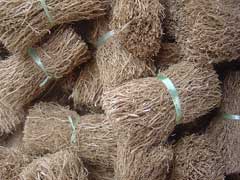 |
|
|
 |
| commons.wikimedia.org/wiki/User:David.Monniaux |
Translate this page:
Summary
NOTE: See Chrysopogon zizanioides (L.) Roberty for a more recent update of this plant.
Physical Characteristics

 Vetiveria zizanioides is an evergreen Perennial growing to 1.6 m (5ft) by 1.6 m (5ft).
Vetiveria zizanioides is an evergreen Perennial growing to 1.6 m (5ft) by 1.6 m (5ft).
See above for USDA hardiness. It is hardy to UK zone 8 and is frost tender. The species is hermaphrodite (has both male and female organs).
Suitable for: light (sandy), medium (loamy) and heavy (clay) soils. Suitable pH: mildly acid, neutral and basic (mildly alkaline) soils. It can grow in semi-shade (light woodland) or no shade. It prefers moist soil.
UK Hardiness Map
US Hardiness Map
Synonyms
Chrysopogon zizanioides. Anatherum zizanioides
Plant Habitats
Cultivated Beds;
Edible Uses
Edible Parts:
Edible Uses: Condiment
The roots are aromatic and are used as a food flavouring[169]. An essential oil obtained from the roots is used as a flavouring in sherbets, syrup sweets, fruit drinks and canned asparagus[46, 301]. It is used in certain canned foods, such as asparagus and peas, to reinforce the natural odour and taste[310].
References More on Edible Uses
Medicinal Uses
Plants For A Future can not take any responsibility for any adverse effects from the use of plants. Always seek advice from a professional before using a plant medicinally.
The essential oil obtained from the roots is used medicinally as a carminative, diaphoretic, diuretic, emmenagogue, refrigerant, stomachic, tonic, antispasmodic and sudorific[310]. A stimulant drink is made from fresh rhizomes[310]. The plants are used as an anthelmintic[310].
References More on Medicinal Uses
The Bookshop: Edible Plant Books
Our Latest books on Perennial Plants For Food Forests and Permaculture Gardens in paperback or digital formats.

Edible Tropical Plants
Food Forest Plants for Hotter Conditions: 250+ Plants For Tropical Food Forests & Permaculture Gardens.
More

Edible Temperate Plants
Plants for Your Food Forest: 500 Plants for Temperate Food Forests & Permaculture Gardens.
More

More Books
PFAF have eight books available in paperback and digital formats. Browse the shop for more information.
Shop Now
Other Uses
Essential Pot-pourri Soil stabilization
The aromatic roots are used in pot-pourri and perfumes[169, 272]. The essential oil from the roots is used in perfumery[272]. The plant has deep-rooted and far-ranging roots that make it a valuable plant for controlling soil erosion in cultivated fields. It is often planted along the contour lines for this purpose.
Special Uses
References More on Other Uses
Cultivation details
This species cannot tolerate hard frosts. In areas that experience much frost, it is better to divide up the plant in the autumn, potting up the divisions and over-wintering them in a greenhouse before planting them back outdoors in late spring[169]. Vetiveria grass is a fast-growing grass that is non-invasive, very deep rooting, insect and vermin proof. It is drought-resistant, and also withstands inundation. It is much planted in the tropics and sub-tropics where its extensive root system makes it valuable for erosion control. Vetiveria zizanioides (syn Chrysopogon zizanioides) is a plant of the tropics, where it is found at elevations up to 2,500 metres. It grows best in areas where annual daytime temperatures are within the range 22 - 35°c, but can tolerate 12 - 45°c[418]. When dormant, the plant can survive temperatures down to about -15°c, but young growth can be severely damaged at 0°c[418]. It prefers a mean annual rainfall in the range 500 - 2,500mm, but tolerates 200 - 5,000mm[418]. Prefers a moisture-retentive soil in full sun[200]. Succeeds in a very wide range of soils, tolerating occasional waterlogging once established[418]. Plants are very tolerant of saline soils[418]. Prefers a Ph in the range 4.5 - 8, tolerating 3 - 9.9[418]. A yield of 1 - 5 tonnes of dried roots per hectare can be harvested annually, at an oil content of 0.7 - 2.5%, this produces 40 - 100 kilos of essential oil[418].
References Carbon Farming Information and Carbon Sequestration Information
Temperature Converter
Type a value in the Celsius field to convert the value to Fahrenheit:
Fahrenheit:
The PFAF Bookshop
Plants For A Future have a number of books available in paperback and digital form. Book titles include Edible Plants, Edible Perennials, Edible Trees,Edible Shrubs, Woodland Gardening, and Temperate Food Forest Plants. Our new book is Food Forest Plants For Hotter Conditions (Tropical and Sub-Tropical).
Shop Now
Plant Propagation
Seed -
Other Names
If available other names are mentioned here
Native Range
TROPICAL ASIA: India (Assam, Bihar, Madhya Pradesh, Meghalaya, Odisha, Tamil Nadu, Uttar Pradesh, West Bengal), Sri Lanka, Pakistan (Punjab), Indochina, Myanmar, Thailand
Weed Potential
Right plant wrong place. We are currently updating this section.
Please note that a plant may be invasive in one area but may not in your area so it's worth checking.
Conservation Status
IUCN Red List of Threatened Plants Status :

Growth: S = slow M = medium F = fast. Soil: L = light (sandy) M = medium H = heavy (clay). pH: A = acid N = neutral B = basic (alkaline). Shade: F = full shade S = semi-shade N = no shade. Moisture: D = dry M = Moist We = wet Wa = water.
Now available:
Food Forest Plants for Mediterranean Conditions
350+ Perennial Plants For Mediterranean and Drier Food Forests and Permaculture Gardens.
[Paperback and eBook]
This is the third in Plants For A Future's series of plant guides for food forests tailored to
specific climate zones. Following volumes on temperate and tropical ecosystems, this book focuses
on species suited to Mediterranean conditions—regions with hot, dry summers and cool, wet winters,
often facing the added challenge of climate change.
Read More
Expert comment
Author
(L.)Nash.
Botanical References
200
Links / References
For a list of references used on this page please go here
Readers comment
© 2010, Plants For A Future. Plants For A Future is a charitable company limited by guarantee, registered in England and Wales. Charity No. 1057719, Company No. 3204567.